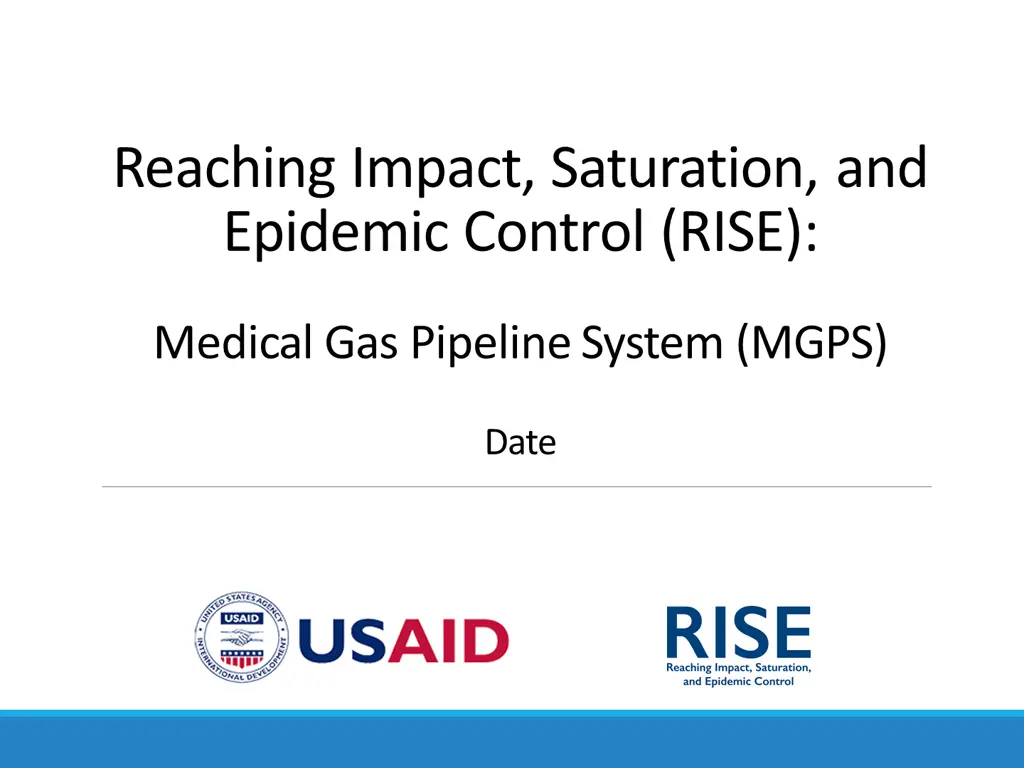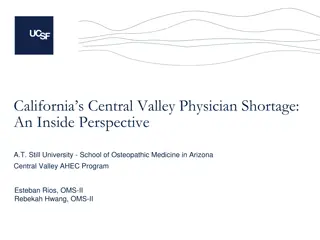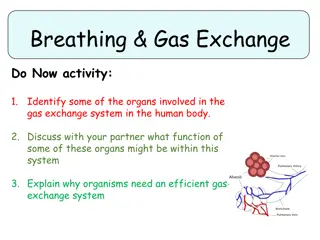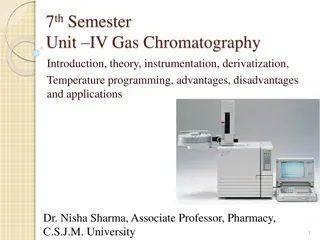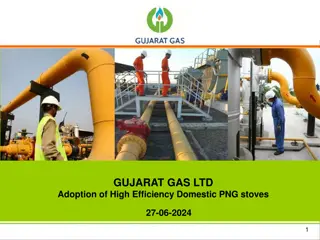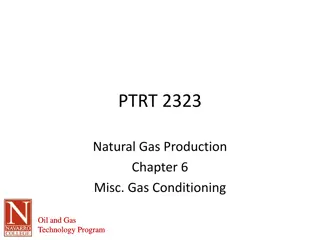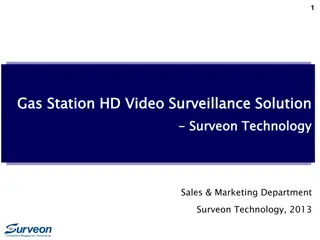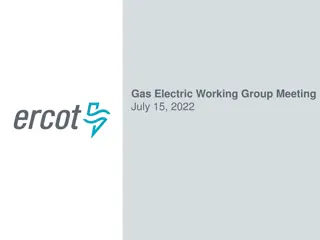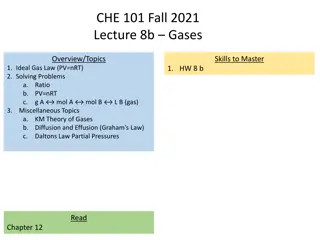Central Medical Gas Distribution System Advantages
Explore the benefits of Centralized Medical Gas Delivery System, including clean supply, space efficiency, and safety features for hospital wards. Learn about oxygen, medical air, and other gases used in medical settings.
Download Presentation

Please find below an Image/Link to download the presentation.
The content on the website is provided AS IS for your information and personal use only. It may not be sold, licensed, or shared on other websites without obtaining consent from the author. Download presentation by click this link. If you encounter any issues during the download, it is possible that the publisher has removed the file from their server.
E N D
Presentation Transcript
Reaching Impact, Saturation, and Epidemic Control (RISE): Medical Gas Pipeline System (MGPS) Date
Session: Introduction to MGPS and its Components
What Is Central Medical Gas Distribution System? Medical Gas Distribution System is a central supply system to supply a medical gas (O2, N2O, N2), medical air, and medical vacuum to each ward of hospital safely and conveniently through a central supply piping from medical gas supply sources. The system has a thoroughgoing color coordination according to the kind of gas. An audio-visual monitoring system capable of checking the situation.
Advantages Of Centralized Medical Gas Delivery System No distressing sign of oxygen cylinder at bed side. Elimination of noise produced be movement. their Protection of sterile areas from contamination caused by use and movement of cylinder. Uninterrupted and clean gas supply at each workstation. Safe And Relief System Effective economically advantageous and hygienic. use of space. Additionally, it is
Types Of Medical Gases Oxygen- used for respiratory therapy and life- support and is additionally used in anesthetic procedures. Medical air-This is supplied by a specialized air compressor to patient care areas. Used extensively in the ICU, PICU, and NICU areas, to reduce the risk of excess oxygen in the lungs, during surgical procedures. Surgical air is used, at a higher pressure, to power a variety of surgical tools and other devices. Nitrous oxide is used for anesthetic and analgesic purposes.
Types Of Medical Gases Helium/oxygen mixture is used to treat patients with respiratory or airway obstruction. Carbon dioxide in used in the medical world to aid laparoscopic examination. The carbon dioxide inflates the stomach slightly which simplifies internal visibility inside the abdomen. Piped vacuum or Suction is provided by means of centrally sited vacuum pumps & supports evacuation procedures.
Medical Gas Pipeline System (MGPS) Manifold room Manifold control panel (digital) Manifold control panel (analog) Manifold alarm system (analog)
Fundamental Principles Standards Designed as per IS 7396, to withstand the pressure at every different section of the oxygen piping system Color Oxygen pipeline in India is painted either in white or painted in yellow with white colored patches throughout the pipeline Pressure Near the LMO plant Wards and zones : General delivery : > 5 - 7 bars : >15 bars 4-5 bars
Fundamental Principles Working Oxygen pipeline system should gradually taper If the pressure requirement at the delivery point is higher than the outlet pressure of the oxygen source, then pipe diameter should gradually decrease. Increment and decrement in MGPS pipe diameter is done according to the pressure regulation and pressure drop compensation. Construction Divided the pipeline system into different zones Have pressure gauges to show pressure in the zones Have a master alarm and zonal alarms if there is a drop in pressure
Components of MGPS Pressure Regulatory Valve (PRV) Non-return Valve (NRV) Master Control Alarm Pressure Gauge The components should be in accordance with the IS 7396, as quality of these components are very vital in ensuring that oxygen pipeline system is able to meet the expectations
Sources Sources are supplies that produce the flow of medical gases through piping networks. The four main sources for medical gases are: It consists of special insulated vessels, vaporizers, and regulators Oxygen, nitrous oxide and carbon dioxide are supplied to large hospitals in cryogenic tanks Bulky Systems It consists of high-pressure cylinders on 2 banks, one is back up to other. The main control panel is installed for primary and secondary regulators, pressure regulators and warning lamps. Manifold Systems These are 2 or more compressors equipped with a receiver, derivers, regulators, filters, dew point monitors, and carbon dioxide alarms. Medical Air Treatment Systems Vacuum pumps are mechanized devices that create a negative pressure in the piping system A reservoir tank is used for storage to permit cycling on and off Vacuum Pumps
Valves Area valve service unit The 2 type of valves are: Zone valves Service valves Zone valves are used to isolate large parts of the system i.e. rooms for modification and/ or repair Zone valves are placed on corridor walls and should be labelled to indicate the rooms they control Service valves used to isolate certain part of the system for modification and/ or repair. They are accessible by the clinical staff. Area valve service units (AVSUs) are placed in clinical sector to cutoff the gas delivery to the area beyond it during maintenance or to handle emergency Area alarm panel (AAP) display the line pressures and have audiovisual alerts. Area alarm panel
Warning And Alarming Systems The 2 main alarm systems are Master alarm Area alarm Master alarm monitors the main gas lines and sources conditions Area alarms are found on alarm panels and their function is to monitor the condition of specific critical care area
Outlets And Inlets Diamond Outlets are points to which connection can be made to the medical gas piping system to supply gases under pressure, while inlets are to supply vacuum Chemetron The final delivery points are color coded, incorporating either the diameter index safety system or are of the quick connect type available in two varieties Diamond Chemetron
Secondary Equipment Hoses, gas flow meters, gauge and vacuum regulator can contribute substantially to gas and vacuum consumption Check them as a part of routine inspection procedures
Session: Pipeline Distribution System, Safety, And Handling
Pipeline Distribution System Pipeline Testing
Main Lines Riser Lines Lateral Lines Branch Lateral Lines
Pipeline Distribution System Design Number of stations: Outlet/ inlets are often called stations for each specific gas type. It is estimated by the medical planner, or the architect based on the requirement of the facility. Flow rates: The flow rate and diversity factors vary for individual stations depending on requirement (the total number of terminal units and the type of provided care). Pressure range is usually kept in between 4 bar to 4.2 bar. Medical gas outlet/ inlet terminals: Various types of it are provided from different manufacturers. The terminals are available in various gas sequence center-line spacing, and concealed mounting
Color Coding For Gas Pipelines
Color Coding For Gases In MGPS The international standard for the color coding of gas pipeline is ISO 32: 1977 Gas pipelines for medical use Marking for identification of content. According to the ISO standard, oxygen should be labelled as white. The figure shows differences in gas pipeline color coding between ISO and US standards.
Usage of Medical Gases The functional areas of the proposed building where in, the Medical gas shall be required is as follows: Operation Theatre O2, N2O, CA, MA, Vac Cath Labs O2, CA, Vac Intensive Care Beds O2, CA, Vac Recovery Beds O2, CA, Vac General Beds O2, CA, Vac
Precautions with MGPS Consult a biomedical engineer / professional designer Do not randomly add ventilators on your existing oxygen piping system Construct a high-capacity oxygen piping from the plant from scratch and take it to the ICU unit Distribute new ventilators across the floor in the different sections of the oxygen piping There should be at least one person at any given point of time who understands the entire oxygen pipeline layout Train and appoint dedicated manpower across all shifts Every ward or every zone should have zone or ward wise drawings of the MGPS with clear indication of pressure settings and valve positions There should be display of the entire oxygen pipeline layout with pressure setting and the valve positions at centrally accessible places in hospitals
Safety Principles Identity is assured using gas-specific connections throughout the pipeline system, including terminal units, connectors etc., adhere to strict testing and commissioning procedures of the system Identity Depends on accurate assessment of demands and the selection of plant appropriate to the clinical/ medical demands on the system Adequacy It is achieved by the specification of system that has duplicate components. The provision of alarm systems and connection to the emergency power supply system. Surgical air system are not considered to be life-support system and therefore duplicate components are not normally required, an emergency/ secondary supply is provided Continuity It is achieved using gases purchased to the appropriate Ph. Eur. Requirements or produced by plant performing to specific standards, by the maintenance of cleanliness throughout the installation of the system, and by the implementation of the various testing and commissioning procedures. Quality of supply
Fire Safety Fire detection system such as smoke or heat detector heads should be installed in the plantrooms, medical gases manifold rooms and medical gases cylinder stores in hospital An automatic shutdown system, linked to local smoke detector can be installed An automatic emergency supply manifold system is sited well away from the fire risk area and is arranged to come on-line automatically in the event of plant shutdown
Precaution Handling MGPS Formulating SOPs and maintaining logbooks Preventive maintenance of equipment Leak test of pipeline should be ensured on quarterly basis 24 hrs manning by trainer personnel Periodic training of manifold personnel Daily checking of contingency plan Mock drills of pipeline failure, fire and explosion should be regularly conducted Managing pressure of different sources so as to manage cumulative flow Ensuring if all sources are contributing in a cumulative manner or any source is failing to supply oxygen due to pressure difference
Thank You! Thank You! This presentation was made possible with support from the United States Agency for International Development funded RISE program, under the terms of the cooperative agreement 7200AA19CA00003. The contents are the responsibility of the RISE program and do not necessarily reflect the views of USAID or the United States Government.
